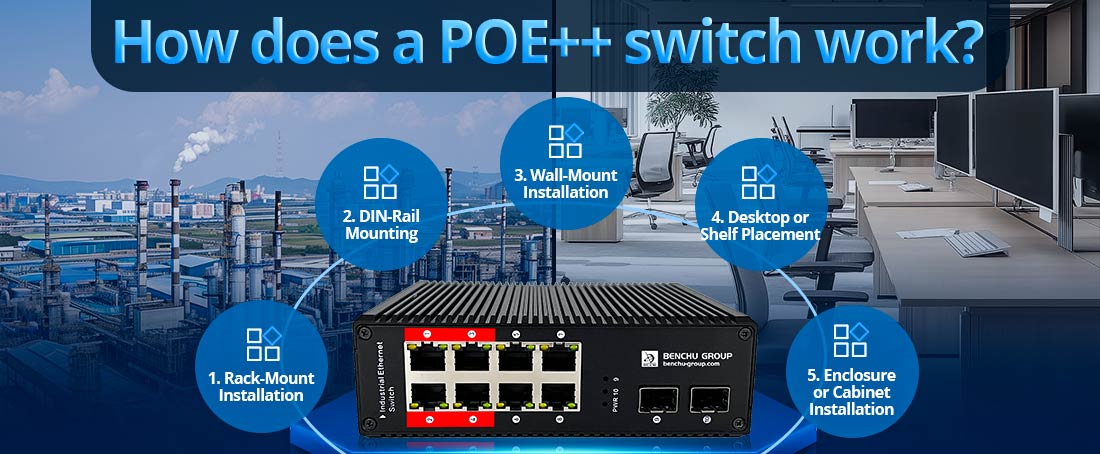
Коммутатор PoE++ работает, передавая питание и данные через кабели Ethernet, особенно на устройства, которым требуется более высокая мощность, чем стандартная. PoE (питание через Ethernet) и PoE+ может обеспечить. В отличие от более ранних версий PoE, которые обеспечивают мощность 15,4 Вт (PoE) или 30 Вт (PoE+) на порт, PoE++ может обеспечивать мощность до 60 Вт или 100 Вт на порт, что позволяет питать более широкий спектр устройств с более высокими требованиями к мощности.
Основной рабочий механизм коммутаторов PoE++
1. Подача электроэнергии через Ethernet
PoE++ коммутаторы используйте кабели Ethernet, обычно кабели категории 5e или категории 6, для передачи питания и данных на подключенные устройства. Это достигается за счет стандарта IEEE 802.3bt, который позволяет питанию проходить через две или все четыре пары витых проводов кабеля Ethernet, в зависимости от требований к питанию подключенного устройства.
--- Тип 3 PoE++ (до 60 Вт): использует четыре пары проводов, но позволяет использовать устройства с меньшим энергопотреблением, используя при необходимости только две пары.
--- PoE++ типа 4 (до 100 Вт): используются все четыре пары проводов для обеспечения максимальной мощности для устройств с высоким энергопотреблением.
2. Обнаружение и классификация мощности
Коммутаторы PoE++ используют механизмы обнаружения и согласования, чтобы определить, совместимо ли подключенное устройство (устройство с питанием или PD) с PoE, и определить его требования к питанию перед подачей питания.
--- Обнаружение: когда устройство подключено, коммутатор PoE++ проверяет линию, чтобы определить, поддерживает ли она PoE, подавая небольшой тестовый ток и измеряя отклик. Это гарантирует, что питание не будет передаваться на устройства, не поддерживающие PoE, и предотвратит возможное повреждение.
--- Классификация: после обнаружения коммутатор PoE++ классифицирует устройство в зависимости от его потребностей в питании. Стандарт IEEE 802.3bt определяет класс 8 (100 Вт) для PoE++, что позволяет коммутатору регулировать выходную мощность в зависимости от конкретного класса каждого устройства. Классификация также помогает эффективно управлять распределением мощности между несколькими портами, гарантируя, что каждое подключенное устройство получает правильную мощность.
3. Распределение мощности и балансировка нагрузки
--- Коммутатор PoE++ распределяет мощность по своим портам в соответствии с классификацией мощности каждого устройства. В конфигурациях с высокой плотностью критическим фактором становится запас мощности коммутатора (максимальная общая мощность, которую он может обеспечить). Усовершенствованные коммутаторы PoE++ часто оснащены интеллектуальным управлением питанием, которое динамически распределяет мощность, снижая риск перегрузки. Если подключенному устройству требуется больше энергии, чем оставшийся бюджет мощности коммутатора, коммутатор может отдать приоритет определенным устройствам или задержать включение дополнительного устройства.
4. Изоляция данных и питания
--- Хотя для питания и данных используется один и тот же кабель Ethernet, коммутатор PoE++ гарантирует, что они работают по разным цепям внутри устройства. Это предотвращает помехи данных и обеспечивает одновременную передачу данных и энергии. Изоляция достигается с помощью специализированной схемы, которая разделяет сигналы питания и данных, обеспечивая стабильное соединение без ухудшения качества данных.
5. Регулирование тепла и напряжения
--- Поскольку более высокие уровни мощности выделяют больше тепла, коммутаторы PoE++ оснащены улучшенными решениями для охлаждения, такими как встроенные вентиляторы или радиаторы. Кроме того, переключатель регулирует напряжение, подаваемое на каждое устройство, поддерживая его в безопасном диапазоне, чтобы избежать перегрева и потенциального повреждения переключателя или подключенных устройств.
Практический пример: PoE++ в работе
Рассмотрим коммутатор PoE++, развернутый в большом офисном здании для обеспечения безопасности и подключения. Этот коммутатор питает несколько мощных IP-камер с возможностью поворота, наклона и масштабирования и точками доступа Wi-Fi 6. Когда каждое устройство подключено, переключатель:
--- Определяет, совместимо ли каждое устройство с PoE++.
--- Классифицирует требования к питанию каждой камеры и точки доступа.
--- Обеспечивает до 60 Вт для каждой камеры (если она относится к типу 3) и до 100 Вт для определенных точек доступа (тип 4).
--- Постоянно контролирует энергопотребление, чтобы обеспечить эффективное распределение и предотвратить перегрузку, что очень важно, когда коммутатор приближается к максимальному бюджету мощности.
Ключевые соображения и механизмы безопасности
--- Защита от сбоев: коммутаторы PoE++ оснащены встроенными функциями безопасности, предотвращающими попадание избыточной мощности на устройства, не поддерживающие PoE. Сюда входит защита от короткого замыкания и защита от неправильной полярности.
--- Динамическое распределение мощности: если устройства удаляются или добавляются, коммутатор динамически перераспределяет доступную мощность для поддержания баланса между портами.
--- Предотвращение перегрузки: коммутатор может отключать питание определенных портов, если мощность устройства превышает мощность коммутатора, гарантируя, что критически важные устройства останутся в сети.
Таким образом, коммутаторы PoE++ эффективно управляют и обеспечивают высокий уровень мощности по кабелям Ethernet, определяя требования к устройствам, интеллектуально распределяя мощность и поддерживая стабильность сети. Они идеально подходят для питания энергоемких устройств, одновременно упрощая прокладку кабелей и снижая затраты на установку, что делает их очень ценными в средах с высокими требованиями.